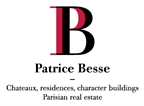A neo-Gothic church converted into a comfortable home in a commanding position, 40 minutes east of Clermont-Ferrand - ref 731289
A neo-Gothic church converted into a comfortable home in a commanding position, 40 minutes east of Clermont-Ferrand.
This former church was built in 1884 and it has been deconsecrated for 40 years. It lies in France's beautiful Puy-de-Dôme department, beside a hamlet and the Livradois-Forez regional nature park. It is five minutes away from a historical town that offers amenities and shops for everyday needs. You can reach the A75 and A89 motorways in 20 minutes and Clermont-Ferrand airport in just 25 minutes. The town of Vichy is one hour away from the property. The surrounding countryside is lush and undulating. It is dotted with old villages and medieval chateaux.
The 19th-century church is crowned with a slate roof. The edifice was built with local stone: arkose for the walls and Volvic volcanic stone for the window and door surrounds. The form of the church follows a basic basilican plan: it has a narthex, three bays without side aisles, a transept and a square chancel at the end. The church's square bell tower, the bells of which have been removed, rises up above the bucolic backd-rop and offers a panoramic view of the spectacular surroundings. The building lies in a calm spot by a hamlet. An 800m² lawn edges it. The place is scarcely overlooked. With its slender buttresses, its tall windows and the four levels of its bell tower, the edifice combines elegance with simplicity. Its architecture pleasantly blends pale arkose with dark volcanic stone.
The neo-Gothic churchA front flight of three steps leads up to the entrance door, which stands in a Gothic arch with two columns. The bell tower that rises straight above the entrance has three floors above the ground floor. The first floor features a rose window of Volvic stone. The second one is the former bell-ringer's room, filled with natural light from a Gothic double window. And on the top level, which once housed the bells, there are four double openings - one on each side of the bell tower. A spiral staircase leads up to the different floors. The nave's walls are punctuated with three tall windows and buttresses. The north and south ends of the transept are each filled with natural light from a single large window and the chancel is filled with natural light from two big windows.
The ground floor
The interior stands out for its brightness and for the plainness of its decor. Its cross vaults rest directly upon the walls. These walls are plastered up to points where the vaults rise up. On the south side, the nave windows have been extended down to the ground for extra light. Slabs of Volvic stone cover the floor. The nave's central section offers an extensive space that forms a dining room worthy of a palace. A fitted kitchen with much work space takes up the chancel. The north end of the transept has been turned into a lounge and library. The south end of the transept forms an entrance hall. In the western section, a raised floor lies level with the bottom of the windows and covers the area of the first two bays. The ground floor includes a vast lounge, a bedroom and a bathroom. Slabs of volcanic stone cover the floor.
The upstairs
A long straight flight of stairs climbs up alongside the northern wall, leading from the centre of the nave up to a raised floor where a pleasant lounge lies and looks down at the nave. A raised floor also lies in the south end of the transept. Up here, a bedroom and a shower room have been created. And there is an office on the first floor of the bell tower. The front rose window fills it with natural light.
The terrace
In the western section, a spiral staircase adjoining the bell tower leads up to the old tribune, which is filled with natural light from a five-foil window, then to the former bell-ringer's room, and, lastly, to a top-floor terrace with a floor area of 20m² where the ...


